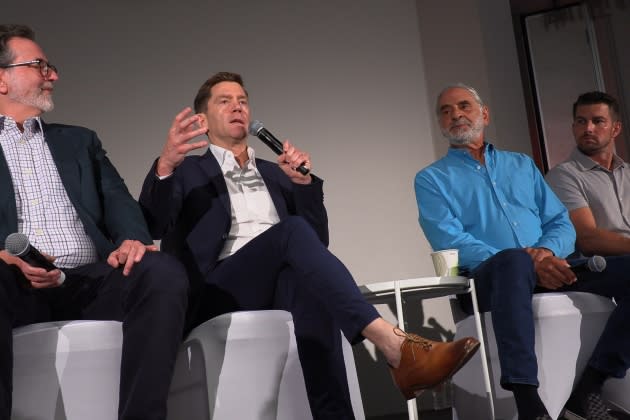‘Top Gun: Maverick’ Production Team Elaborates On Location Scouting, Navy Partnership

From filming jets soaring between 12,000-foot mountains in the Cascades to capturing a dynamic sailing sequence in San Francisco, the production team behind Top Gun: Maverick scoured remote regions of the West coast working hand-in-hand with the Navy to realize the script’s lofty vision to the big screen. The decision-makers behind the movie, which joined the billion-dollar club over the weekend, gathered Wednesday to talk about the logistics of shooting the blockbuster.
The Hollywood insiders discussed the movie at a brunch honoring the industry’s top physical production pros during a multiday networking event from June 27 to June 30 hosted by the Association of Film Commissioners International (AFCI), a group made up of more than 300 commissioners on six continents. The brunch, a joint effort between AFCI and The Hollywood Reporter, saw a turnout of dozens of productions executives across the major studios, who chatted over quiche, fruit platters and pastries.
More from The Hollywood Reporter
'Top Gun: Maverick,' 'Stranger Things' Among Location Managers Guild Awards Nominees
'Elvis' Croons Past 'Top Gun: Maverick' to Win Rare Box Office Dance-Off With $31M
Featured in the panel was Lee Rosenthal, president of physical production for Paramount Pictures and Nickelodeon as well as Top Gun: Maverick executive producer Tommy Harper, location manager Mike Fantasia and aerial coordinator Kevin LaRosa. The conversation, which was moderated by THR editorial director Nekesa Mumbi Moody, covered the scouting of filming locations to partnering with the Navy to shoot the movie.
“We had to quickly formulate a plan to get our feet in the door in California,” Harper said. “But the one thing we all talked about in speaking to the Navy is that we had to figure out where the jets were. You don’t want to set up shop somewhere and then travel to the jets. You want to be where the jets are and manipulate the shoot and schedule accordingly. We were thankful that we could shoot the whole film all in California and a little bit in Nevada and Washington.”
Once he figured out where the jets were, Fantasia detailed scouting distinct geographic areas for each flying sequence that was made available to the production by the Navy.
“You don’t just fly F-18s at a 650,000 miles per hour anywhere,” he said. “So we looked at military operating areas and saw how some fit well for the script and some didn’t. We melded the script and the locations, and we ended up flying a lot… in the Death Valley area. That was for one part of the sequence. And then we flew out of Fallon for a couple of other sequences. Then we went north to Whidbey Island to fly in the Cascades, which is probably aerial wise, the most challenging place because you’re flying in deep, deep valleys — 12,000-foot mountains around you. If there’s a problem, it’s going to be a while before they find you because you’re in the middle of nowhere.”
Fantasia added that the Navy was instrumental during the scouting process to see how filming of the jets would translate to the big screen. He recalled, “We would say ‘Geez, it’s great to get [a view of the] landscape, but it’d be great to see the jet there. The Navy would say ‘Get up there tomorrow and we’ll fly over.'”
Rosenthal observed that director Joseph Kosinksi actually “shot two movies — an air story and a ground story.” On the logistics of splitting up filming into the two categories, Harper said, “We kind of devised production schedule. Okay, we’re going to shoot the ground story like every other movie is shot with a full crew. And then we had our aerial crew… We got it down to such a fine, detailed amount of people — maybe 70, which is not that many people — who’d travel when we shot aerials. We scaled down as efficiently as we could to shoot the aerial story separate from the ground.”
The panelists recalled an instance when they had to change the production schedule and relocate when an aircraft carrier couldn’t leave the port it was docked in.
“We had to pivot,” Harper said. “We had to figure out something for two days. We didn’t shut down. We had to crane decommissioned planes onto the carrier overnight so we can film the next day and get hundreds of extras on the carrier. We kept the crew on the carrier sleeping dockside, so we never shut down. We were always maneuvering.”
Harper noted that shutting down production was never an option. He added, “There’s no insurance for this type of thing. You know you’re going to spend money to get jets out of depo. You know you’re spending money on a crane operator. I don’t know how much money that is. I do know it’s a lot cheaper than shutting down.”
But the insiders said the carrier malfunctioning wasn’t even the biggest obstacle of shooting the movie. That honor, they said, went to the sailing scene from Jennifer Connelly’s character. According to them, the problem was that there was no wind at a harbor in San Pedro where it was initially supposed to be shot. They ended up deciding to move the scene to shoot in San Francisco.
Asked about why the movie resonated with viewers, LaRosa said the production spared no expense and never settled for mediocrity.
“Here’s the Top Gun rule that I love: There’s always an aircraft behind the lens,” he said. “There’s always a subject aircraft. There’s always a pilot flying it.”

